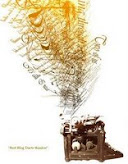Yesterday you read about a few of Graeme Base’s picture books. Hopefully you’re read at least a few.
Graeme Base does a lot of research for each of his illustrations. He learns about the direction a zebras stripes run, the way a toucan’s beak is colored, the way a rhino’s legs bend. He takes that information and adds his own ideas to create illustrations that are full of fun and fantasy.
Today, create your own imaginary animal (without all the research!). This is simple project but you’ll need a big imagination to complete it.
(You should know that Graeme Base doesn’t use oil pastels to create his illustrations. He uses paint and sometimes colored pencils on top. He does use tracing paper to make different versions of his drawings before painting the final product, though.)
Supplies Needed:
Thin Paper (such as sketch paper)
Pencil
Oil Pastels
Q-Tips
 It’s completely up to you what you want to draw. Maybe you want to combine a hippo with a canary. Maybe you want to draw a dog that can breathe underwater. Maybe you’ll create something completely new that no one has ever heard of before. It’s completely up to you.
It’s completely up to you what you want to draw. Maybe you want to combine a hippo with a canary. Maybe you want to draw a dog that can breathe underwater. Maybe you’ll create something completely new that no one has ever heard of before. It’s completely up to you.
Start by sketching your creature. When you’re completely happy with it, trace over the lines so they’re nice and dark. Lay another sheet of thin paper over your sketch and tape the two sheets together.
 Now color your drawing using oil pastels. Because oil pastel smears pencil, your artwork will come out much cleaner if you don’t color straight onto the pencil drawing.
Now color your drawing using oil pastels. Because oil pastel smears pencil, your artwork will come out much cleaner if you don’t color straight onto the pencil drawing.
Remember that you can blend oil pastels together by rubbing over them with a Q-Tip. Experiment with the pastels by blending different colors together. Your imaginary animal can be any colors you want so you can’t make a mistake with color. Continue to play with the pastels until you are happy with your creation. If you and several of your friends are all creating imaginary creatures, you might think about cutting out your animals and using a glue stick to attach them to one background page. Then you’ll have a forest full of creatures!
Continue to play with the pastels until you are happy with your creation. If you and several of your friends are all creating imaginary creatures, you might think about cutting out your animals and using a glue stick to attach them to one background page. Then you’ll have a forest full of creatures!
When you’ve finished, name your creature and write a story about it. This would be especially fun if you and a group of friends worked together on a story starring all of your creatures.
Return to main page.
Graeme Base does a lot of research for each of his illustrations. He learns about the direction a zebras stripes run, the way a toucan’s beak is colored, the way a rhino’s legs bend. He takes that information and adds his own ideas to create illustrations that are full of fun and fantasy.
Today, create your own imaginary animal (without all the research!). This is simple project but you’ll need a big imagination to complete it.
(You should know that Graeme Base doesn’t use oil pastels to create his illustrations. He uses paint and sometimes colored pencils on top. He does use tracing paper to make different versions of his drawings before painting the final product, though.)
Supplies Needed:
Thin Paper (such as sketch paper)
Pencil
Oil Pastels
Q-Tips
 It’s completely up to you what you want to draw. Maybe you want to combine a hippo with a canary. Maybe you want to draw a dog that can breathe underwater. Maybe you’ll create something completely new that no one has ever heard of before. It’s completely up to you.
It’s completely up to you what you want to draw. Maybe you want to combine a hippo with a canary. Maybe you want to draw a dog that can breathe underwater. Maybe you’ll create something completely new that no one has ever heard of before. It’s completely up to you.Start by sketching your creature. When you’re completely happy with it, trace over the lines so they’re nice and dark. Lay another sheet of thin paper over your sketch and tape the two sheets together.
 Now color your drawing using oil pastels. Because oil pastel smears pencil, your artwork will come out much cleaner if you don’t color straight onto the pencil drawing.
Now color your drawing using oil pastels. Because oil pastel smears pencil, your artwork will come out much cleaner if you don’t color straight onto the pencil drawing.Remember that you can blend oil pastels together by rubbing over them with a Q-Tip. Experiment with the pastels by blending different colors together. Your imaginary animal can be any colors you want so you can’t make a mistake with color.
 Continue to play with the pastels until you are happy with your creation. If you and several of your friends are all creating imaginary creatures, you might think about cutting out your animals and using a glue stick to attach them to one background page. Then you’ll have a forest full of creatures!
Continue to play with the pastels until you are happy with your creation. If you and several of your friends are all creating imaginary creatures, you might think about cutting out your animals and using a glue stick to attach them to one background page. Then you’ll have a forest full of creatures!When you’ve finished, name your creature and write a story about it. This would be especially fun if you and a group of friends worked together on a story starring all of your creatures.
Return to main page.








5 comments:
If you use thicker paper like water color, canvas paper, or illustration board you can dip your Q-tips in baby oil and r-e-a-l-l-y blend the colors for a nice smooth oil painted look. It does bleed through the paper though hence the need for thicker paper.
I can't wait to find out who the next illustrator will be. Have you ever seen David Wisniewski's cut paper illustrations? Amazing stuff. One of his books is called Sundiata.
Thanks for the tip, Julie. The colors definitely do look richer if you blend with baby oil but the pencil lines created a mess when I did that. Maybe if I could just relax and do it without the pencil in the first place...
I think I'm going to give it another try.
No, I had not ever seen David Wisniewski's illustrations. I went and looked at a few and they're pretty amazing. I'm going to try to work him in. Thanks!
This is very cool. Another option would be to use Linseed Oil instead of baby oil. Really creative though, thanks.
I like the baby oil when working with kids, but for grown ups linseed oil might be better. I've never had a problem with the pencil lines becoming messy though. Maybe use less saturation of oil on the Q-tip or a harder pencil lead. Most of the time on our kids projects we outline the lines with black sharpie first, but that doesn't work all that well when you want a more realistic look.
PS Still thinking about the knight project for you.
Thanks Julie! I tried your baby oil technique and I got top marks in my painting for school!! I really love how the oil makes the colours so rich and bold! Thanks again
Post a Comment